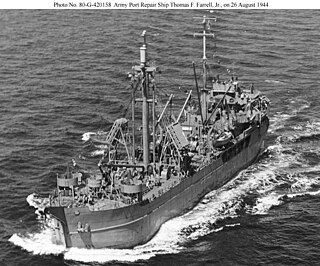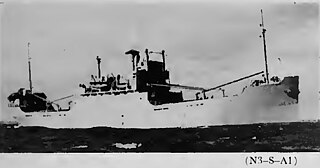
The first USS Astoria (SP-2005/AK-8) was a steel-hulled, coal-burning steam cargo ship of the United States Navy.
USS Lancaster may refer to the following ships of the United States Navy:

USS Electra (AKA-4) was an Arcturus-class attack cargo ship named after Electra, a star in the Pleiades star cluster in the constellation Taurus. She served as a commissioned ship for seven years.

Europa (AK-81) was never commissioned and thus never bore the USS designation.

Nashira (AK-85) was planned as a civilian cargo ship for the United States Maritime Commission, transferred to the Navy for construction then transferred to the U.S. Army and renamed two days after launching. The ship was never commissioned, thus never bore the USS designation, and had no significant naval service. The ship was converted to the U.S. Army Engineer Port Repair ship Richard R. Arnold and served in the Pacific during 1945.

USS Enceladus (AK-80) was an Enceladus-class cargo ship commissioned by the U.S. Navy for service in World War II. She was responsible for delivering goods and equipment to locations in the war zone.
USS Mira has been the name of two proposed United States Navy ships:

Sagitta (AK-87) was never commissioned and thus never bore the USS designation.

Vela (AK-89) was never commissioned and thus never bore the USS designation. The ship was transferred to the Army to become the Engineer Port Repair Ship Joe C. Specker shortly after launching. She was one of two such repair ships transferred to Navy in 1952 and served as the civilian crewed, unarmed USNS Vela (T-AK-89).
USS Somerset (AK-212) was an Alamosa-class cargo ship that was constructed for the US Navy during the closing period of World War II. She was later acquired by the US Army in 1946 and the US Air Force in 1957 before being reacquired by the USN as the USNS Coastal Sentry (T-AGM-15), a missile range instrumentation ship.
USS Shearwater is a name used more than once by the United States Navy:
USS Fairfield (AK-178) was an Alamosa-class cargo ship acquired by the U.S. Navy during the final months of World War II. She served in the Pacific Ocean theatre of operations and was decommissioned shortly after war’s end.
USS Hennepin (AK-187) was an Alamosa-class cargo ship that served the US Navy during the final months of World War II. Post-war she served briefly with the US Army as USAT Hennepin, and then as USNS Hennepin (T-AK-187) with the Military Sea Transportation Service (MSTS) where she was awarded a battle star. She was declared excess-to-needs on 27 March 1959.
USS Herkimer (AK-188) was an Alamosa-class cargo ship that served the US Navy during the final months of World War II. Post-war she served in the Pacific Ocean theatre of operations for some time with the US Army as USAT Herkimer, and then as USNS Herkimer (T-AK-188), with the Military Sea Transportation Service (MSTS) from 1950 to 1973. She was then transferred to the navy of the Trust Territory of the Pacific Islands (TTPI).
USS Muskingum (AK-198/T-AK-198) was an Alamosa-class cargo ship that was constructed for the US Navy under a US Maritime Commission (MARCOM) contract during the closing period of World War II. She supported the end-of-war Navy effort. On 7 March 1946 Muskingum was placed in service under bareboat charter with the US Army under the Shipping Control Authority for the Japanese Merchant Marine with a Japanese crew. In 1950 she was reactivated and placed into service with the Military Sea Transportation Service as USNS Muskingum (T-AK-198) until being struck from the Navy list in 1973. She was ultimately transferred to the Trust Territory of the Pacific Islands (TTPI) and the Republic of Palau.

USS Pembina (AK-200) – later known as USNS Pembina (T-AK-200) -- was an Alamosa-class cargo ship that was constructed for the U.S. Navy during the closing period of World War II. She supported the end-of-war Navy effort and was subsequently placed in service with the US Army under the Shipping Control Authority for the Japanese Merchant Marine with a Japanese crew in Yokosuka, Japan.
USNS Sgt. George Peterson (T-AK-248) was a US Maritime Administration (MARCOM) C1-M-AV1 type coastal cargo ship, originally planned as an Alamosa-class cargo ship. The contract for building was canceled by the Navy in August 1945. The ship, however, was completed as SS Coastal Guide. She was later acquired by the US Army, in 1948, and renamed USAT Sgt. George Peterson. She was reacquired by the Navy, in 1950, and placed in service by the Military Sea Transportation Service (MSTS) as USNS Sgt. George Peterson (T-AK-248). She remained with the Navy until struck in 1966. She was sold in 1971.
USNS Private John F. Thorson (T-AK-247) was a US Maritime Administration (MARCOM) C1-M-AV1 type coastal cargo ship, originally planned as an Alamosa-class cargo ship. Constructed as Becket Bend for MARCOM, completed in August 1945 and placed in operation by the War Shipping Administration. However, the war ended, and she was transferred to the US Army as USAT Private John F. Thorson who kept her in service until transferred to the US Navy in 1950. She was struck in 1960, ending her military career.

Type N3-S ships were a Maritime Commission small coastal cargo ship design to meet urgent World War II shipping needs, with the first of the 109 N3, both steam and diesel, type hulls delivered in December 1942.
This page is based on this
Wikipedia article Text is available under the
CC BY-SA 4.0 license; additional terms may apply.
Images, videos and audio are available under their respective licenses.





